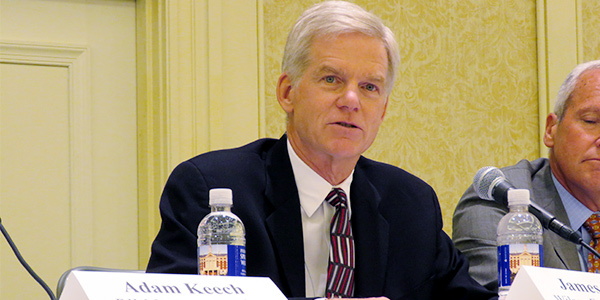By Rory D. Sweeney
PJM has already missed its Board of Managers’ deadline for revising how it forms prices in its energy market, evoking the question: How much longer will the process drag on?
In April, the board instructed RTO staff to identify changes that could be in place for this winter and asked stakeholders “to deliberate timely” so a proposal could be sent to FERC in the third quarter. (See PJM Board Seeks Reserve Pricing Changes for Winter.) Staff emphasized at a meeting of the Energy Price Formation Senior Task Force (EPFSTF) last Friday that the deadline has passed and asked stakeholders to prepare for a vote at the task force’s next meeting on Nov. 1.
“We’ve missed that [deadline] already, so we’re trying to work as expeditiously as possible to respect their request,” PJM’s Dave Anders said.
However, stakeholders pushed back.
“I really want to be able to respect the board’s wishes, and I do respect them. I’m not sure if I can in good conscience honor them. I just don’t think we’re ready to vote,” Old Dominion Electric Cooperative’s Adrien Ford said. “I want to get this right, and I don’t want a board letter to be the reason we don’t get it right.”
“I don’t want to throw in the towel and say this will take as long as it takes,” Anders said in response to the hesitation. He asked stakeholders to come prepared to work toward a vote at the next meeting.
Part of the hang-up might be that PJM has presented all its arguments for why the market should be reformed, and stakeholders aren’t convinced. PJM’s Adam Keech asked what details the RTO hasn’t provided yet.
“There are a lot of eyes on what this group accomplishes,” he said.
“For me, the main thing that’s been missing and that’s always been missing is the motivation for this,” said James Wilson of Wilson Energy Economics, who consults for several consumer advocates within the RTO’s footprint. “I don’t really think you’ve made the case that reserves beyond [the minimum reserve requirement] are worth several hundred dollars.”
The task force has been attempting to resolve concerns that the energy market doesn’t properly attract resources with the benefits, or attributes, necessary for grid reliability. In July, PJM unveiled a proposal to procure reserves on a more granular level, along with implementing nodal reserve pricing, a real-time 30-minute reserves product and flexible sub-zone modeling. At a task force meeting last month, PJM’s Independent Market Monitor proposed revising the operating reserve demand curve to compare the value of purchasing reserves now to fill potential shortages later, rather than purchasing them later during the peak hours of the day. (See PJM Price Formation Group Talks Reserves.)
The Monitor’s Catherine Tyler revisited the proposal at last week’s meeting, explaining that the point of the plan is to avoid turning on more units than necessary while also capturing in prices the cost of operator actions taken to avoid reserve shortages. The proposal prompted skepticism for an apparent disconnect in how paying for reserves now could reduce scarcity risks later in the day.
Tyler said the Monitor’s proposal is “selectively targeting the times when the market would procure additional reserves,” unlike PJM’s.





